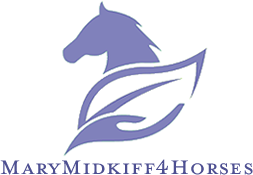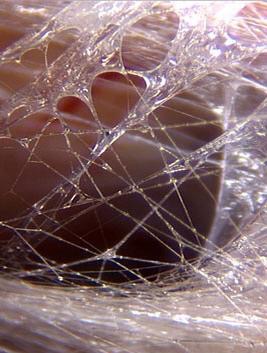
What is this wet, sticky, stringy web of stuff? It’s called FASCIA and it is in all living things! It’s a thin layer of connective tissue that surrounds and holds every organ, blood vessel, bone, nerve fiber and muscle in place. It is the network of life and the organ of shape in the horse’s body, and in yours!
When you see the shape of a horse you are seeing the shape of the fascia. If you took away the skeleton and muscles you would still see the same shape. Fascia shows every dent, scar, swelling, imbalance, tension and hyperextension in the body. Fascia can even indicate pain as the connective tissue may be restricting joints, muscles, tendons and ligaments from functioning freely as well as nerves and blood vessels from staying open and relaying.

Fascia lies just under the skin layer between the skin and muscle. When we touch the skin we can feel some level of movement under the skin. This is the fascial tissues engaging, linking, reaching within itself to find connections. Fascia is made up of mainly collagen and elastic fibers which are constantly moving and weaving as the body needs to move and bend.
Adhesions can form in fascia from lack of movement. It can become gummy and crinkle up which turns into lesions, bumps, lumps in the fascia which are restrictions and stop or disallow freedom of movement. An injury, trauma, surgery, disease, malformation can all be disruptive and damaging to fascia. The collagen reforms and regenerates the connective tissue in the shape it is given after the trauma. And it stays that way unless there is manual therapy or a modality is introduced to loosen, moisten, and energize the fascia. The scar tissue may not be fully restored but may have the ability to return to a healthy functioning level of movement. It is definitely worth the effort to restore scar tissue.
Whether around or near a joint, in a muscle group, wrapping around tendons and ligaments or healing of an area such as a castration site, it is worth stretching and working with the fascia to create allowance. Once the fascia begins opening and allowing again pain subsides, inflammation decreases and mobility increases.
Below is an example of a fascial adhesion. The fascia and muscle have become static and stagnate and caused a lump or swelling which appears to be permanent. This type of swelling/lump can be caused by direct trauma such as bumping the hindquarter in a trailer or stall, a kick from another horse, a hyperextension of a muscle or joint, an insect sting or bite or perhaps a chronic rub area from lying down and getting up on that side. It is not causing the horse pain so much as it is prohibitive to the muscles in the area. Namely the biceps femoris and quadriceps. This lesion is also sitting on top of the femur bone and may be causing some friction. The horse may be able to function just fine with this old lesion but it can be worked on with manual and/or modality therapy to start unwrapping the layers of damaged connective tissue. We all have bumps and lumps from our past traumas and activities and we can live with them. However, it is always helpful in athletic and active pursuits as well as keeping the blood/oxygen flow and nerve messages as fully functioning as possible.
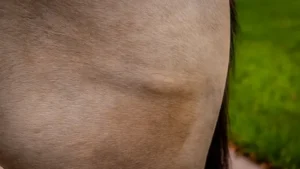
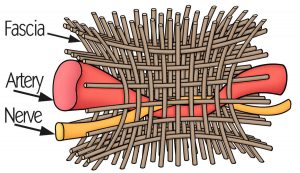
In this illustration you can see the fascia connective tissue is in order and functioning in balance; the arteries, nerves and blood vessels are fully functional. However, if the fascia becomes tight, unorganized, scarred, loose or disconnected it can restrict and damage the electrical and blood supply to the muscles, tendons and ligaments. Like a kink in a hose, it can restrict the flow of messages and blood/oxygen supply to the brain and nervous system! Maybe now a memory or two comes up in your mind about why your horse changed in behavior and personality until they had sufficient body work and myofascial release work.
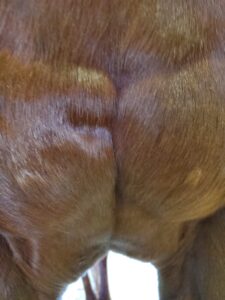
I visited this horse to work on a particular issue and as I evaluated the horse head-on saw this chest presentation.
The complaint was that the horse was not as forward moving and as open in their stride as they used to be a year ago.
What do you see comparing side to side? Which side of the sternum in the pectoral muscles looks healthy and functioning and which side looks restricted, damaged and overworking?
As you look at the photo, on the right side (or left side of the horse) you can see a well formed strong set of pectoral muscles extending down through the girth area and abdominal seam. On the left side of the photo (or right side of the horse) we see indentations or scars from perhaps a former injury, infection, disease or the way the horse has over used this muscle group. Follow this side down through the abdominal seam and you can see the swelling and enlargement of the entire muscle group.
The restrictive fascia in one area can affect the entire thoracic sling and therefore the rib cage.
You can clearly see how this swelling and disrupted connective tissue is holding the muscles in this damaged shape which then limits the shoulder, elbow, front limb joints.
It’s helpful when evaluating or assessing horses to compare side to side or bilaterally. Are they equal, the same shape and size, or are they different and how? Make notes of these differences and work with your physiotherapist to balance out your horse no matter how old they are.
In this case, the fascia has re-shaped around the injuries and held them in these deformed shapes of dents, swellings, sucked-in areas, bulges and atrophy. Myofascial release will begin to open and stretch the fascia to allow the healing and re-fill of the connective tissue surrounding the muscles, blood vessels, tendons, ligaments and nerve innervation. Without changing the fascia the muscles will always be restricted and contained disallowing full range of motion, joint fluidity and function. No wonder the horse has become short-strided and less willing to move forward carrying the rider’s weight.
Remember too that we usually mount our horses on the left side. This causes the right side to have to brace to hold our weight as we press down on the stirrup and swing our leg over. As we incorrectly pull the pommel and cantle, (see image below) this torque on the skeleton, pulls on the withers and spine. The horse has to brace against our weight with every mount. You can see the horse’s tail being held off to the left as the rider gets on. He’s literally shifting his weight to the right and trying to hold her up as she pulls the saddle over. As a result, horses can develop right side muscular imbalances and issues. It’s so important to be elevated on a mounting block when mounting to not pull and put weight on the left side of the horse. If possible, mount your horse from both sides intermittently. And as you mount, place one hand on the horse’s withers, grab mane if you need to and place your other hand on the seat of the saddle and slide it over to the opposite side. Hold onto the skirt if you need to; then land softly in the saddle.
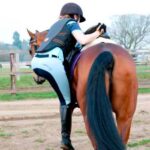
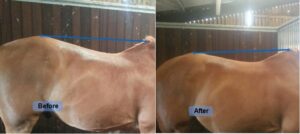
In these before and after photos the horse’s body and shape show us what unhealthy and healthy fascia can look like. You need to develop an eye for it.
First of all note the blue line drawn from wither to croup/sacrum and look at the dip in the thoracic and lumbar spine. The Before photo indicates a severe drop between these two large bony tuberosities. The suspension between the wither and the sacrum has dropped and there is additional swelling and vein protrusion in the abdomen. Note also the bulge of the quadricep muscles and stifle joint. The horse appears tight and generally tense all over. Basically shortened in length overall.
In the After photo the space under the blue line has come up and filled in, the wither has actually come up a few inches to make the wither/croup line level and the abdominals are relaxed. Over all there is a softness under the skin and the horse has filled out, even the coat quality has improved.
This is a good example of how fascia can restrict various parts and the horse as a whole being. Once a therapist goes through the horse with myofascial release work the whole network of fascia and all of those connecting collagen webs expand, hydrate and re-energize, then every other part of the body opens and flourishes.
Doing ground work with horses before you ride or as exercises is very helpful in opening and stretching fascia as well. Bending the head and neck slowly in an S pattern around the arena asking them to step sideways in the proper manner lifting and placing each foot in balance and having them stretch down as you walk them through poles or over obstacles. This will also open the neuropathways for them to think and understand what you are asking.
If you are interested in learning more about fascia, about myofascial work and and how it can benefit you and your horse please don’t hesitate to contact me.
I hope to catch up with you soon in Essex and surrounding counties. The UK for that matter! Best wishes
Mary Midkiff
marymidkiff@gmail.com
Facebook: Essex Equine Musculoskeletal Body Work
marymidkiff4horses.com
Be aware of your horse’s shape throughout his/her body. Do they have a full, hydrated, healthy appearance or are they tense, tight, dry, sucked-in, and restricted? Take before and after photos during body work sessions that you or a professional perform. You need to know about fascia and how important a role it plays in your horse’s health – mental, physical and emotional.
